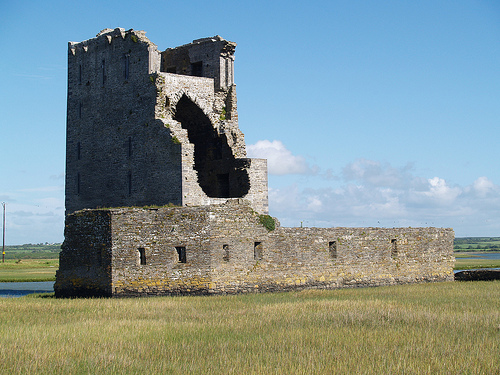

Location: County Kerry Map
Constructed: 1490s by Conor Liath O'Connor-Kerry
Carrigafoyle Castle is a medieval tower house surrounded by the wall in a County Kerry in Ireland. Carrigafoyle Castle was constructed in 1490s by Conor Liath O'Connor-Kerry.
Carrigafoyle Castle (Irish Caisleán Charraig an Phoill) –
originally built by Conor Liath O'connor-Kerry in the 1490s – was
considered one of the strongest Irish fortifications of this time
and was typical of castles in Munster. It consisted of two Main
buildings (towers). The complex was slightly elevated on a rock in a
small Bay of Shannon. The name derives from the Irish Carraig to
Phoill. The strategic significance of the castle was the control of
the shipping routes that supplied goods to the trading town of
Limerick, 32 km away; therefore, the castle was considered the
guardian of the Shannon. By an English conquest the supply route
would be cut off and English troops could arrive directly to
Limerick.
The Bay before the fortification was secured on the northern side by
a wooded island. Double walls were erected to the west of the
complex; the inner Wall surrounded the castle courtyard and was
surrounded by a moat. The Keep was good 25 meters high. During the
flood, the Shannon was able to lay directly on a fortified landing
strip within the ditch.
During the Desmond Rebellion, the castle was occupied by 50 Irish
and 16 Spanish soldiers who arrived in Smerwick in 1580 and were
part of the papal invading force. Among them were women and
children. A few months earlier, the Italian engineer Captain Julian
began to revise the defensive structures according to the
instructions of Eleanor, the gravely Desmond. At the time of the
siege, the Countess had already travelled to Castleisland to her
husband, but Julian had not yet finished his work.
The English commander Sir William Pelham, along with George Carew
and a 600-man army of Sir William Winter, moved through Munster.
Winter also commanded a sea-based army that helped fight the
Rebellion. Upon arriving at Carrigafoyle Castle, the English force
snatched southwest of the castle and built their artillery along a
low wall about 100 meters north of the outer fortification wall. At
the northernmost point of this wall, a company of foot soldiers with
lances was placed in position.
The English troops bombarded the castle for two days (6 hours a day)
with three so-called demi-cannons (Half the guns in the fleets of
the 17th century. Century, which is fired instead of a 42-pound
projectile, only a 32-pound shell) and a Kalverine (a big gun with
small projectiles). Both types of cannons originate from winter's
ships and were fired by sea cannons. In addition, in the mouth of
the river outside the Bay there were three three Masters at anchor,
who also used their cannons.
On the first day of the siege (Palm Sunday), Pelham ordered a force
to cross the wall on the sea side – but the men were stretched down
by gunfire and slain by rocks thrown on them by the defensive gear.
The partially deployed assault ladders were simply repelled by the
Spanish Helle cards. During the bombing, Pelham was hit and wounded
by a ricochet and mocked by the besieged, but the attack continued
abruptly.
On the second day, Pelham received regrouping of troops from
winter's ships. The final attack, led by Captain Humfrey, don worth
and John Zouche, focused on the part of the castle, which was most
of the guns removed and in which the defenders were. After two or
three full hits, the tower eventually collapsed and buried several
defenders. Some of the survivors fled through the shallow water, but
were either shot or killed with the sword. The remaining besiegers
were brought to the English Camp and hung on trees. Captain Julian
was the last to be executed after three days.
The strategic significance of this siege is clear from the fact that
after the news of the fall of the castle spread, the other
fortifications of the Desmond could be conquered very quickly. The
rebels retreated instead, and went in the guerrilla struggle.
The castle of Carrigafoyle was so badly damaged by the siege that it
was never repaired. The ruins, including the outer defence system –
and the damage done by the bombing are still visible today.